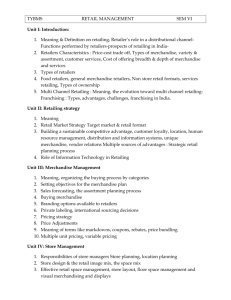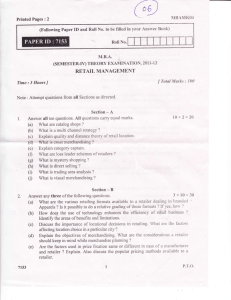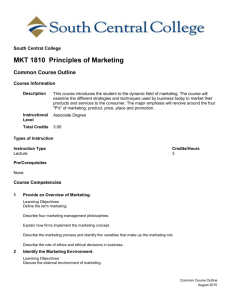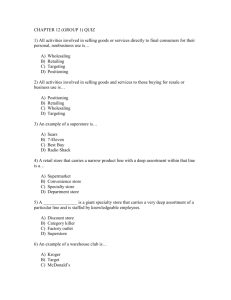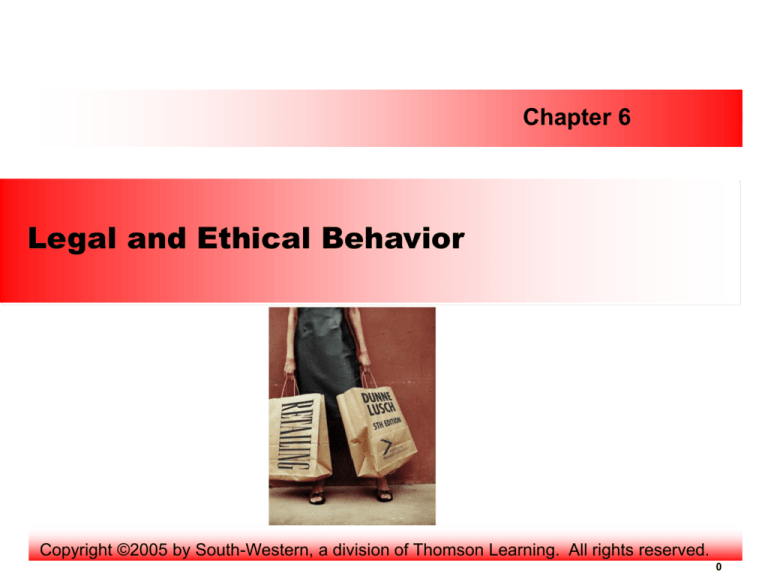
Chapter 6
Legal and Ethical Behavior
Copyright ©2005 by South-Western, a division of Thomson Learning. All rights reserved.
0
Learning Objectives
• Explain how legislation constrains a retailer’s pricing
policies.
• Differentiate between legal and illegal promotional
activities.
• Explain the retailer’s responsibilities regarding the
products sold.
1
Learning Objectives
• Discuss the impact of governmental regulation on a
retailer’s behavior with other supply chain members.
• Describe how various state and local laws, in addition
to federal regulations, must also be considered in
developing retail policies.
• Explain how a retailer’s code of ethics will influence its
behavior.
2
Ethical and Legal Constraints Influencing
Retailers
Ethical Behavior
Buying Merchandise
Selling Merchandise
Retailer-Employee
Relationship
Exhibit 6.1
Major Federal Laws
Pricing Constraints
Promotional Constraints
Product Constraints
Supply Chain Constraints
Retail
Decision
Maker
State and Local Laws
Zoning
Unfair Trade Practices
Building Codes
Blue Laws
Franchise Laws
Green River Ordinances
State Licenses
Other Federal Laws
Mergers/Acquisitions
Trade Agreements
Human Resources
Tax
SEC Regulations
Americans with Disabilities
3
Primary U.S. Laws that Affect Retailing
Exhibit 6.2
• Sherman Act, 1890
Impact on Retailing:
Bans (1) “monopolies or attempts to monopolize” and
(2) “contracts, combinations, or conspiracies in
restraint of trade” in interstate and foreign commerce.
4
Primary U.S. Laws that Affect Retailing
Exhibit 6.2
• Clayton Act, 1914
Impact on Retailing:
Adds to the Sherman Act by prohibiting specific
practices (e.g., certain types of price discrimination,
tying clauses) “whereas the effect… may be to
substantially lessen competition or tend to create a
monopoly in any line of commerce.”
5
Primary U.S. Laws that Affect Retailing
Exhibit 6.2
• Federal Trade Commission Act, 1914
Impact on Retailing:
Establishes the Federal Trade Commission, a body of
specialists with broad powers to investigate and to
issue cease-and-desist orders to enforce Section 5,
which declares that “unfair methods of competition in
commerce are unlawful.”
6
Primary U.S. Laws that Affect Retailing
Exhibit 6.2
• Robinson-Patman Act, 1936
Impact on Retailing:
Amends the Clayton Act, adds the phrase “to injure,
destroy, or prevent competition.” Defines price
discrimination as unlawful (subject to certain
defenses) and provides the FTC with the right to
establish limits on quantity discounts, to forbid
brokerage allowances except to independent brokers,
and to ban promotional allowances or the furnishing of
services or facilities except when made available to all
“ on proportionately equal terms.”
7
Primary U.S. Laws that Affect Retailing
Exhibit 6.2
• Wheeler-Lea Amendment to the FTC Act, 1938
Impact on Retailing:
Prohibits unfair and deceptive acts and practices
regardless of whether competition is injured.
• Lenham Act, 1946
Impact on Retailing:
Establishes protection for trademarks.
8
Primary U.S. Laws that Affect Retailing
Exhibit 6.2
• Celler-Kefauver Antimerger Act, 1950
Impact on Retailing:
Amends Section 7 of the Clayton Act by broadening
the power to prevent corporate acquisitions where the
acquisition may have a substantially adverse effect on
competition.
• Hart-Scott-Rodino Act, 1976
Impact on Retailing:
Requires large companies to notify the government of
their intent to merge.
9
Examples of Laws Designed to Protect
Consumers
• Mail Fraud Act, 1872
Exhibit 6.3
Impact or Change in Consumer Environment:
Makes it a federal crime to defraud consumers through
use of the mail.
• Pure Food & Drug Act, 1906
Impact or Change in Consumer Environment:
Regulates interstate commerce in misbranded and
adulterated foods, drinks, and drugs.
10
Examples of Laws Designed to Protect
Consumers
• Flammable Fabrics Act, 1953
Exhibit 6.3
Impact or Change in Consumer Environment:
Prohibits interstate shipments of flammable apparel or
material.
• Automobile Information Disclosure Act, 1958
Impact or Change in Consumer Environment:
Requires auto manufactures to post suggested retail
prices on new cars.
11
Examples of Laws Designed to Protect
Exhibit 6.3
Consumers
• Fair Packaging and Labeling Act, 1966
Impact or Change in Consumer Environment:
Regulates packaging and labeling; establishes uniform
sizes.
• Child Safety Act, 1966
Impact or Change in Consumer Environment:
Prevents the marketing and selling of harmful toys and
dangerous products.
12
Examples of Laws Designed to Protect
Consumers
• Truth in Lending Act, 1968
Exhibit 6.3
Impact or Change in Consumer Environment:
Requires lenders to state the true costs of a credit
transaction; established a National Commission on
Consumer Finance.
• Fair Credit Reporting Act, 1970
Impact or Change in Consumer Environment:
Regulates the reporting and use of credit information;
limits consumer liability for stolen credit cards to $50.
13
Examples of Laws Designed to Protect
Exhibit 6.3
Consumers
• Consumer Product Safety Act, 1972
Impact or Change in Consumer Environment:
Creates the Consumer Product Safety Commission.
• Magnuson-Moss Warranty/FTC Improvement Act, 1975
Impact or Change in Consumer Environment:
Empowers the FTC to determine rules concerning
consumer warranties and provides for consumer
access to means of redress, such as the “class action”
suit; expands FTC regulatory powers over unfair or
deceptive acts or practices.
14
Examples of Laws Designed to Protect
Exhibit 6.3
Consumers
• Equal Credit Opportunity Act, 1975
Impact or Change in Consumer Environment:
Prohibits discrimination in credit transactions because
of gender, martial status, race, national origin, religion,
age, or receipt of public assistance.
15
Pricing Constraints
LO 1
Horizontal Price Fixing
Vertical Price Fixing
Price Discrimination
Deceptive Pricing
Predatory Pricing
16
Pricing Constraints
LO 1: Exhibit 6.4
Below-cost
Pricing Laws
Horizontal
Price-Fixing
Laws
Vertical
Price-Fixing
Laws
Pricing
Decisions
Predatory
Pricing Laws
Deceptive
Pricing Laws
Price
Discrimination
Laws
17
Pricing Constraints
LO 1
Horizontal Price Fixing
Occurs when a group of competing retailers (or other
channel members operating at a given level of
distribution) establishes a fixed price at which to sell
certain brands of products.
18
Pricing Constraints
LO 1
Vertical Price Fixing
Occurs when a retailer collaborates with the
manufacturer or wholesaler to resell an item at an
agreed-on price.
19
Pricing Constraints
LO 1
Price Discrimination
Occurs when two retailers buy an identical amount of
“like grade and quality” merchandise from the same
supplier but pay different prices.
20
Pricing Constraints: Price Discrimination
LO 1
Price Discrimination
Cost Justification Defense: a differential in price could
be accounted for on the basis of differences in cost to
the seller in the manufacture, sale, and/or delivery.
Changing Market Conditions Defense: price differential
based on the danger of imminent deterioration of
perishable goods or seasonal goods.
Meeting Competition in Good Faith Defense: Made in
good faith in order to meet an equally low price of a
competitor.
21
Pricing Constraints
LO 1
Deceptive Pricing
Occurs when a misleading price is used to lure
customers into the store; usually there are hidden
charges or the item advertised may be unavailable.
22
Pricing Constraints
LO 1
Predatory Pricing
Exists when a retail chain charges different prices in
different geographic areas to eliminate competition in
selected geographic areas.
23
Promotion Constraints
LO 2
Deceitful Diversion of Patronage
Deceptive Advertising
Deceptive Sales Practices
24
Promotion Constraints
LO 2
Palming Off
Occurs when a retailer represents that merchandise is
made by a firm other than the true manufacturer.
25
Promotion Constraints
LO 2: Exhibit 6.5
Deceptive
Sales
Practices
Deceitful
Diversion of
Patronage
Promotion
Decisions
Deceptive
Advertising
26
Deceptive Advertising
LO 2
Deceptive Advertising
Occurs when a retailer makes false or misleading
advertising claims about the physical makeup of a
product, the benefits to be gained by its use, or the
appropriate uses for the product.
27
Deceptive Advertising
LO 2
Bait-and-Switch Advertising
Advertising promoting a product at an unrealistically
low price to serve as “bait” and then trying to “switch”
the customer to a higher-priced product.
28
Deceptive Sales Practices
LO 2
Failing to be honest or omitting key facts in either ad
of the sales presentation.
Using deceptive credit contracts.
29
Product Constraints
LO 3
Product Safety
Product Liability
Warranties
30
Product Constraints
LO 3: Exhibit 6.6
Product
Warranties
Product
Safety
Product
Decisions
Product
Liability
31
Product Constraints
LO 3
Product Liability Laws
Deal with the seller’s responsibility to market safe
products. These laws invoke the “foreseeability”
doctrine, which states that a seller of a product must
attempt to foresee how a product may be misused and
warn the consumer against hazards of misuse.
32
Product Constraints
LO 3
Expressed Warranties
Are either written or verbalized agreements about the
performance of a product and can cover all attributes
of the merchandise or only one attribute.
33
Product Constraints
LO 3
Implied Warranty of Merchantability
Is made by every retailer when the retailer sells goods
and implies that the merchandise sold is fit for the
ordinary purpose for which the such goods are
typically used.
34
Product Constraints
LO 3
Implied Warranty of Fitness
Is a warranty that implies that the merchandise is fit for
a particular purpose and arises when the customer
relies on the retailer to assist or make the selection of
goods to serve a particular purpose.
35
Question to Ponder
• How should a retailer balance express and implied
warranties in offering products to customers?
36
Supply Chain Constraints
LO 4
• Territorial Restrictions
• Dual Distribution
• Exclusive Dealing
• Tying Agreements
37
Supply Chain Constraints
LO 4
• Territorial Restrictions
Are attempts by the supplier, usually a manufacturer,
to limit the geographic area in which a retailer may
resell merchandise.
38
Supply Chain Constraints
LO 4
• Dual Distribution
Occurs when a manufacurer sells to independent
retailers and also through its own retail outlets.
39
Dual Distribution
LO 4
Ralph Lauren has a dual
distribution strategy
where it markets its Polo
brand apparel through
its own retail stores as
well as through
traditional department
stores.
40
Channel Constraints
LO 4: Exhibit 6.7
Territorial
Restrictions
Tying
Agreements
Supply
Chain
Decisions
Dual
Distribution
Exclusive
Dealing
41
Exclusive Dealing
LO 4
One-Way Exclusive Dealing
Occurs when the supplier agrees to give the retailer
the exclusive right to merchandise the supplier’s
product in a particular trade area.
• Two-Way Exclusive Dealing
Occurs when the supplier offers the retailer the
exclusive distribution of a merchandise line or product
in a particular trade if in return the retailer will agree to
do something for the manufacturer such as heavily
promote the supplier’s products or not handle
competing brands.
42
Tying Agreements
LO 4
Tying Agreement
Exists when a seller with a strong product or service
requires a buyer ( the retailer) to purchase a weak
product or service as a condition for buying a strong
product or service.
43
Other Federal, State, and Local Laws
LO 5
• Zoning Laws
• Taxing Laws
• Franchise Laws
• Blue Laws
• Unfair Trade Laws
• Building Safety Regulations
44
State, and Local Regulations Affecting
Retailers
Taxing
Laws
LO 5: Exhibit 6.8
Zoning
Laws
Unfair Trade
Practices
Retail
Decision
Maker
Franchise
Laws
Blue
Laws
Building
Safety
Regulations
45
Ethics in Retailing
LO 6
Ethical Behavior in Buying Merchandise
Ethical Behavior in Selling Merchandise
Ethical Behavior in Retailer-Employee Relationship
46
Ethics in Retailing
LO 6
Ethics
Is a set of rules for human moral behavior.
• Explicit Code of Ethics
Consists of a written policy that states what is ethical
an unethical behavior.
• Implicit Code of Ethics
Is an unwritten but well understood set of rules or
standards of moral responsibility.
47
Ethical Behavior in Buying Merchandise
LO 6
Product Quality
Sourcing
Slotting Fees
Bribery
48
Ethical Behavior in Buying Merchandise
LO 6
Slotting Fees (Slotting Allowances)
Are fees paid by a vendor for space or a slot on a
retailer’s shelves, as well as having its UPC number
given a slot in the retailer’s computer system.
49
Ethical Behavior in Selling Merchandise
LO 6
Products Sold
Selling Practices
50
Ethical Behavior in Selling Merchandise
LO 6
• Home Depot’s no
commission sales
approach does not put
the sales person at odds
with the customer.
However, given Home
Depot’s self-service
operation, paying a
commission would be
difficult.
51
Ethical Behavior in the Retailer-Employee
Relationship
LO 6
• Misuse of Company Assets
• Job Switching
• Employee Theft
52
National Retail Federation Principles on
Customer Data Privacy
LO 6: Exhibit 6.9
• General Rule: The privacy of information collected by
a retailer about its customers during the course of
transactions with those customers should be
maintained with the degree of confidentiality that the
retailer reasonably anticipates would be expected of
it by the typical shopper purchasing that type of
merchandise form the retailer. Departures from this
standard should be disclosed to customers at or
before each time of occurrence, unless previously
consented to by the customer or otherwise expressly
permitted by law.
53
National Retail Federation Principles on
Customer Data Privacy
LO 6: Exhibit 6.9
• Practice Principles:
• Each retailer should adopt a customer private policy
explaining its practices with respect to the information
it collects about its customers.
• Policies could either be corporate-wide or divisional
depending upon the manner in which the company
believes customers view its retail operations.
• A retailer should make reasonable efforts to inform its
customers of the existence of its customer private
policies, and make the substance of such policies
available on a regular basis.
54
National Retail Federation Principles on
Customer Data Privacy
LO 6: Exhibit 6.9
• Practice Principles:
• At a minimum, a customer private policy should allow a
customer to elect whether he or she wishes to prevent
the marketing of his or her name to other unaffiliated
corporations, or to “opt out” of future promotional
solicitations from the company(s) to which the policy
applies, or both.
• Retail companies should develop procedures to
reasonably ensure that customer information is not
accessible to, or used by its employees or others in
contravention of its policies and customer elections,
and that access to personally identifiable data for nonpromotional purposes is limited to those individuals
with a customer servicing need to know.
55
Additional Slides
56
Price Discrimination
LO 1
Meeting Competition in
Good Faith Defense
Changing Justifications
for Price
Market
Discrimination
Cost
Conditions
Justification
Defense
Defense
57
Promotional Constraints
LO 2
Deceptive
Sales
Practices
Deceitful
Diversion
of
Patronage
Promotion
Decisions
Deceptive
Advertising
58
Product Constraints
LO 3
Product
Safety
Product
Decisions
Product
Warranties
Product
Liability
59
60



